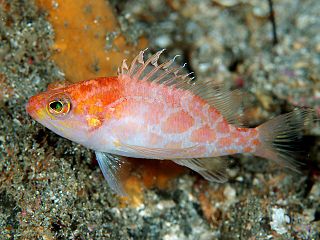
Salamandridae is a family of salamanders consisting of true salamanders and newts. Salamandrids are distinguished from other salamanders by the lack of rib or costal grooves along the sides of their bodies and by their rough skin. Their skin is very granular because of the number of poison glands. They also lack nasolabial grooves. Most species of Salamandridae have moveable eyelids but lack lacrimal glands.

Johan Ernst Gunnerus was a Norwegian bishop and botanist. Gunnerus was born at Christiania. He was bishop of the Diocese of Nidaros from 1758 until his death and also a professor of theology at the University of Copenhagen.

Nicotinamide adenine dinucleotide phosphate, abbreviated NADP+ or, in older notation, TPN (triphosphopyridine nucleotide), is a cofactor used in anabolic reactions, such as the Calvin cycle and lipid and nucleic acid syntheses, which require NADPH as a reducing agent. It is used by all forms of cellular life.

Plectranthias is a genus of ray-finned fish in the subfamily Anthiinae, part of the family Serranidae, the groupers and sea basses. They are found in the Atlantic, Indian and Pacific Ocean.

The Agaricomycetes are a class of fungi in the division Basidiomycota. The taxon is roughly identical to that defined for the Homobasidiomycetes by Hibbett & Thorn, with the inclusion of Auriculariales and Sebacinales. It includes not only mushroom-forming fungi, but also most species placed in the deprecated taxa Gasteromycetes and Homobasidiomycetes. Within the subdivision Agaricomycotina, which already excludes the smut and rust fungi, the Agaricomycetes can be further defined by the exclusion of the classes Tremellomycetes and Dacrymycetes, which are generally considered to be jelly fungi. However, a few former "jelly fungi", such as Auricularia, are classified in the Agaricomycetes. According to a 2008 estimate, Agaricomycetes include 17 orders, 100 families, 1147 genera, and about 21000 species. Modern molecular phylogenetic analyses have been since used to help define several new orders in the Agaricomycetes: Amylocorticiales, Jaapiales, Stereopsidales, and Lepidostromatales.

The Serpulidae are a family of sessile, tube-building annelid worms in the class Polychaeta. The members of this family differ from other sabellid tube worms in that they have a specialized operculum that blocks the entrance of their tubes when they withdraw into the tubes. In addition, serpulids secrete tubes of calcium carbonate. Serpulids are the most important biomineralizers among annelids. About 300 species in the family Serpulidae are known, all but one of which live in saline waters. The earliest serpulids are known from the Permian.

Rhinogobius is a genus of primarily freshwater gobies native to tropical and temperate parts of eastern Asia. Most are small, streamlined in shape, and often sexually dimorphic. Few are of commercial importance, but R. duospilus is fairly widely traded as an aquarium fish.

Elysia is a genus of sea slugs, marine gastropod molluscs in the family Plakobranchidae. These animals are colorful sea slugs, and they can superficially resemble nudibranchs, but are not very closely related to them. Instead they are sacoglossans, commonly known as sap-sucking slugs.

Triplophysa is a genus of fish in the family Nemacheilidae found mainly in and around the Qinghai-Tibet Plateau in China. Currently, the genus is a mixed assemblage of species. Some lineages have been identified and treated as subgenera, but as Wikipedia follows Fishbase for fish species these have been treated as subgenera in Wikipedia, although Kottelat and the Catalog of Fishes treat them as genera. FishBase, however, includes these in Triplophysa without specifying subgenera and treats the names given by Kottelat as synonyms.

The Pleurobranchidae are a taxonomic family of sea slugs, marine gastropod molluscs in the clade Pleurobranchomorpha.

Cirrhochrista is a genus of moths of the family Crambidae described by Julius Lederer in 1863.

Elophila is a genus of moths of the family Crambidae described by Jacob Hübner in 1822.

Paracymoriza is a genus of moths of the family Crambidae.

Platydoris is a genus of sea slugs, dorid nudibranchs, shell-less marine gastropod mollusks in the family Discodorididae. These nudibranchs are large and often brightly coloured, but normally live concealed beneath rocks or loose coral, feeding on sponges. During the night they become more active, searching for new food sources or mates. Many species were described in the 19th century and a revision in 2002 added six new species.

Hydroides norvegica is a species of tube-forming annelid worm in the family Serpulidae. It is found on submerged rocks, shells, piles and boats in many coastal areas around the world. It is the type species of the genus Hydroides.

The Gobionellinae are a subfamily of fish which was formerly classified in the family Gobiidae, the gobies, but the 5th Edition of Fishes of the World classifies the subfamily as part of the family Oxudercidae. Members of Gobionellinae mostly inhabit estuarine and freshwater habitats; the main exception is the genus Gnatholepis, which live with corals in marine environments. The subfamily is distributed in tropical and temperate regions around the world with the exception of the northeastern Atlantic Ocean, the Mediterranean Sea, and the Ponto-Caspian region. It includes around 370 species and 55 genera: Wikipedia articles about genera list about 389 species.
Aglaja is a genus of sea slugs, marine opisthobranch gastropod mollusks in the family Aglajidae.
Thellungiella is a genus of plants in the family Brassicaceae closely related to Arabidopsis, but in the subclade Eutremeae. In recent classifications, the genus is no longer recognized, and the formerly included species are now placed in the genus Eutrema or Schrenkiella.

Cyclic guanosine monophosphate–adenosine monophosphate is the first cyclic di-nucleotide found in metazoa. In mammalian cells, cGAMP is synthesized by cyclic GMP-AMP synthase (cGAS) from ATP and GTP upon cytosolic DNA stimulation. cGAMP produced by cGAS contains mixed phosphodiester linkages, with one between 2'-OH of GMP and 5'-phosphate of AMP and the other between 3'-OH of AMP and 5'-phosphate of GMP.
















